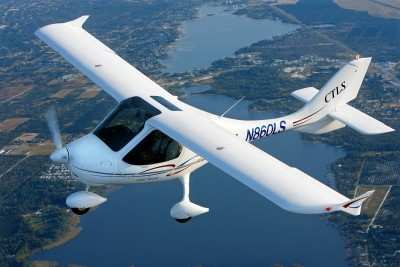Retired UPS Executive Making Airplanes Available For Instruction
Flight schools are struggling across the USA to obtain financing to buy new aircraft to replace aging fleets of trainers. Yet Flight Design USA has found success with another method familiar to schools: the leaseback. Three aircraft are training students today in leased back CTLS Light-Sport Aircraft, but the financial arrangement is only part of the story.

“We are pleased to announce the third CTLS leased to a flight school was used by Iraq war veteran Adam Kisielewski, an Able Flight scholarship recipient who recently earned his Sport Pilot certificate,” said Tom Peghiny President of Flight Design USA. Kisielewski was the 20th student to earn his certificate through the Able Flight program. “The aircraft Adam used was made available by Joe Daguiar, the third time he’s done so.”
Adam Kisielewski is a determined young man who learned to fly without his left arm or his right leg below the knee. That might stop most people from doing something as rigorous as flight instruction, but Adam is not most people. He rides a Harley Davidson motorcycle without any special adaptation and works at Operation Second Chance where he helps other wounded veterans. Adam survived a 2005 explosion when he entered a bomb-rigged door. The blast took the life of a fellow Marine.
The other star of this story, Joe D, as he was known by coworkers, retired recently after several manager positions at UPS in New England. “Joe is a pilot and has taken it on himself to buy three Flight Design aircraft and to make them available on leaseback to flight schools,” detailed Peghiny. The three schools, all in Joe’s region include: Premier Flight Services at Brainard Airport in Connecticut, Northampton Aeronautics in Massachusetts, and, East Hill Flying Club in Ithaca, New York.

“Light-Sport Aircraft have several noteworthy advantages over classic trainers,” said Peghiny. “LSAs use less fuel, can employ mogas options for even more savings, make for better neighbor relations as they are remarkably quiet running, have roomy, comfortable cockpits, and, have modern instrument panels plus other contemporary features that students appreciate.” German company Flight Design Technik also developed a hand control system for the CT series of Light-Sport Aircraft to enable pilots who lack the use of their legs. Kisielewski did not use the system but other scholarship recipients from Able Flight have been grateful for the hand control system that can be fitted to any CTLS model.
To allow Kisielewski to stay closer to his family and work for Operation Second Chance, Able Flight found a CT based at Northampton Aeronautics in Massachusetts. In cooperation with Northampton manager Rich MacIsaac, Joe D’s CT was relocated to Frederick, Maryland, the same airport AOPA calls home. Adam’s flight training was provided by Dean Stickell, a retired Air Force test pilot, and Dave Hirschman, Senior Editor of AOPA Pilot magazine.
“We greatly appreciate Joe D and Rich MacIsaac making Joe’s airplane available for Adam to learn to fly near his home in Frederick,” noted Charles Stites, executive director of Able Flight. “Taking an airplane off the school’s flight line for that amount of time to help a wounded veteran learn to fly speaks very well of Joe, Rich, and Northampton Aeronautics. This was a solution that worked well for Adam and for Able Flight.” Able Flight offers scholarship programs where the organization provides the aircraft. Stites does the work to coordinate this effort and Able Flight pays the costs thanks to generous support from a variety of sponsors and individual donors. “Able Flight typically pays not just for the airplane, but all travel, lodging and test fees during training. However, in Adam’s case we were able to provide his training more cost-effectively since he trained near his home,” added Stites. (CTLS images from file)
 Airbus Racer Helicopter Demonstrator First Flight Part of Clean Sky 2 Initiative
Airbus Racer Helicopter Demonstrator First Flight Part of Clean Sky 2 Initiative Diamond's Electric DA40 Finds Fans at Dübendorf
Diamond's Electric DA40 Finds Fans at Dübendorf ANN's Daily Aero-Term (04.23.24): Line Up And Wait (LUAW)
ANN's Daily Aero-Term (04.23.24): Line Up And Wait (LUAW) NTSB Final Report: Extra Flugzeugbau GMBH EA300/L
NTSB Final Report: Extra Flugzeugbau GMBH EA300/L Classic Aero-TV: 'Never Give Up' - Advice From Two of FedEx's Female Captains
Classic Aero-TV: 'Never Give Up' - Advice From Two of FedEx's Female Captains




